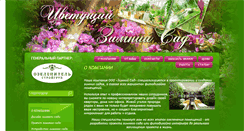Озеленение помещений и создание зимних садов
OVERVIEW
FLOWERING-GARDEN.RU TRAFFIC
Date Range
Date Range
Date Range
LINKS TO FLOWERING-GARDEN.RU
Услуги борьбы с вредителями, болезнями и сорняками. Обрезка плодовых деревьев и кустарников. Опрыскивание и обработка сада от болезней и вредителей. Опрыскивание и обработка сада от болезней и вредителей растений. Вовремя проведенная профилактическая обработка сада поможет сохранить растения от вредоносных вредителей и болезней! Использован.
WHAT DOES FLOWERING-GARDEN.RU LOOK LIKE?



FLOWERING-GARDEN.RU SERVER
FAVICON

SERVER SOFTWARE
We observed that flowering-garden.ru is operating the nginx server.SITE TITLE
Озеленение помещений и создание зимних садовDESCRIPTION
Наша компания ООО Зимний Сад специализируется в проектировании и создании зимних садов, а также всех вариантах фитодизайна помещенийPARSED CONTENT
The domain states the following, "Посадка цветов в зимнем саду." I observed that the web site said " Посадка деревьев в зимнем саду." They also stated " Посадка кустарников в зимнем саду. Посев газона в зимнем саду. Уход за растениями в зимнем саду. Уход за цветами в зимнем саду. Уход за кустарниками в зимнем саду. Уход за деревьями в зимнем саду. Уход за газоном в зимнем саду. Адиантум, или Венерин волос. Алоэ Aloe, или Столетник." The meta header had проект зимнего сада as the first keyword. This keyword was followed by озеленение помещений and фитодизайн помещений which isn't as important as проект зимнего сада.SEE OTHER BUSINESSES
It has very fleshy roots and strap-like leaves of which when it is growing well, it will produce four to six new ones during the growing season. It flowers in the spring. The time to start the tubers into growth is late winter. Or early spring, but the point to bear in mind is that a. Make sure the compost is moist but not wet and do not water until absolutely necessary, as too much. Moisture at this stage before any appreciable root. Be given light shading in the late spring and summer.
FUNDAMENTAL DIFFERENCES IN THE CLASSIFICATION AND NOMENCLATURE OF CULTIVATED AND WILD PLANTS. FUNDAMENTAL DIFFERENCES IN THE CLASSIFICATION AND NOMENCLATURE OF CULTIVATED AND WILD PLANTS. A Ambiguity of the Term Variety. A fundamental difference between the ICNCP and ICBN is their respective.
Tuesday, November 17, 2009. I Really need your help about plants and flowers! I am in wildlife and i need a website that gives me information about plants such as-. Please help me i will leave a lot of feedback and give best answer.
Friday, May 21, 2010. Overwatering kills more plants than underwatering; you may want to look up the specific plant and its requirements to see what it needs in terms of light, water and soil type. Another common problem is moisture either too wet or too dry.
Cultivated for over 1,500 years for its variously colored blossoms, this Japanese apricot has more than 300 cultivars. It has a rounded crown. LEAF Alternate, ovate, hairy, sharply toothed margins. FLOWER Large, white to pink to red, and fragrant; borne singly or in pairs on old wood. FRUIT Spherical to ovoid drupe, fleshy, yellow, barely edible.